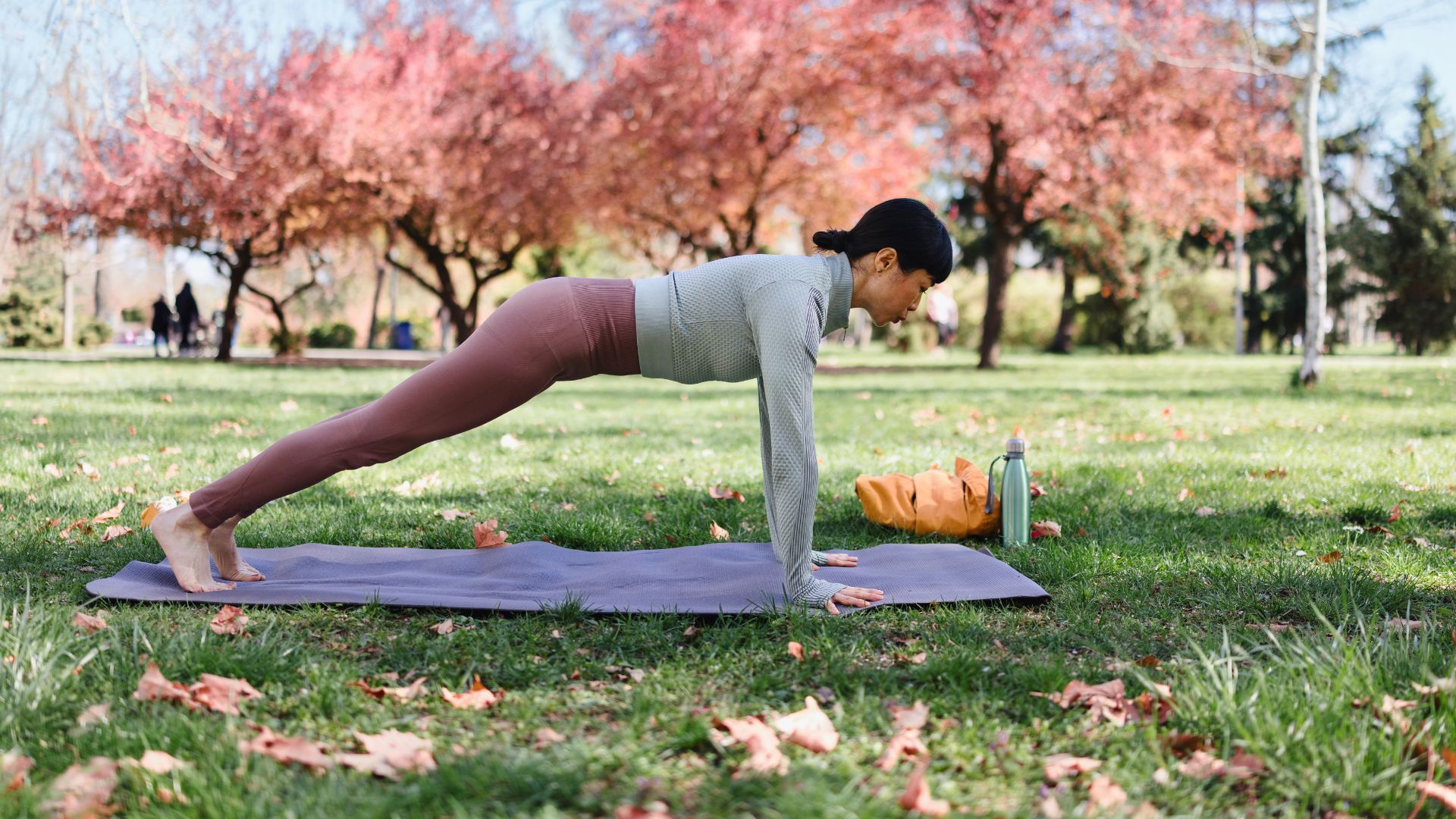So long, crunches - I did shoulder taps instead and built a stronger core with better stability
Shoulder taps are a neck-friendly, bodyweight classic that'll challenge not just your core, but your arm strength and shoulder stability


Working on your core strength can be tough as you age, which is why I love shoulder taps as a way to elevate a classic plank movement.
Childbirth, hormone fluctuations and age-related declining muscle mass (sarcopenia) inevitably affect how strong and stable we feel, not to mention how we train. The last thing my tender, middle-aged neck needs is yet another sit-up, but I know core strength is critical, regardless of age. It’s vital for functional fitness (making those everyday movements a bit easier), balance, and stability (making us less likely to fall), as well as helping to improve posture and reduce lower back pain.
So, in my quest for a new way to train my mid-section without adding insult to (neck) injury, I plumped for trying shoulder taps as an alternative to the classic plank movement in a Pilates workout at home. Spoiler alert: they might just be my new favourite core (and dare I say, full body) move.
What are shoulder taps?
Shoulder taps are a bodyweight workout exercise. While primarily an excellent core move, it works the arms and shoulders too, stabilising the shoulder girdle. Pilates fans may recognise the move as a variation of one of the classic Pilates exercises, too.
"Shoulder taps are a modern adaptation of the classical Pilates exercise 'leg pull prone', where you're in a plank position and alternate lifting one hand to tap the opposite shoulder, all while keeping the hips as steady as possible,” says Aleksandra Warburton, a certified Pilates instructor. “They’re a more dynamic stability challenge for the core, requiring strength, control and full-body awareness.”
Although the move is usually performed from a stable plank position (either forearm or full, depending on your preference and current ability), beginners may want to start in an upright position, leaning their hands against a wall. From here, you’ll slowly lift alternate hands to opposite shoulders with control.
It sounds easy enough, but don't be fooled. Their simplicity belies the exercise's effectiveness.
Sign up to our free daily email for the latest royal and entertainment news, interesting opinion, expert advice on styling and beauty trends, and no-nonsense guides to the health and wellness questions you want answered.
“Shoulder taps are deceptively simple,” agrees trainer and founder of Meet You At The Barre, Jennie Brown, who demonstrates the exercise below. “Every time you lift a hand to tap the opposite shoulder, your core works overtime to prevent your hips from wobbling. It’s anti-rotation at its finest: you’ll recruit and engage those tiny, but all-important stabilising muscles in the core, arms and shoulders all at the same time.”
How to do shoulder taps
- Start in a plank position on your yoga mat, shoulders over wrists, creating a straight line from the back of the neck to your heels.
- Maintain this position by engaging your core. Your back should be flat with no arching, and your hips should be level and pointing downwards.
- Slowly lift one hand off the floor and tap the opposite shoulder, keeping your hips and torso as still as possible.
- Repeat this slowly, alternating sides, for 10 reps to begin with.
- The aim is to minimise side-to-side shifting and movement, and to maintain the plank position.
We know that the key to getting the most benefits from any exercise (not to mention avoiding injury) is to perform it with good technique, so before you go any further, make sure your form is on point.
Benefits of shoulder taps
- Shoulder taps are a full-body exercise: Maintaining a plank position in the unilateral hold requires work throughout the body. You’ll be activating and engaging your quads, glutes, shoulder and arm muscles as well as your core for a full-body burn.
- Improved shoulder stability and strength: Not only does the move require you to maintain a plank, but you’ll also be working your shoulders unilaterally as you raise your arm on each side in turn, building stability across the shoulder girdle. For anyone looking to do Pilates for beginners, shoulder taps can be a great help.
- Stronger upper back and improved posture: “This is really important because your back is actually part of your core as well, especially your upper back,” notes Tara Riley, a Pilates, barre, strength and cardio teacher, and the founder of the Tara Riley Method. “It’s essentially what's going to keep you standing up straight, so it’s an excellent move for improving your posture, too.”
- Strengthens the core: The move engages both the deep core and superficial abs to build strength and stability across the whole core. “To maintain your plank and minimise side to side movement and rotation of your trunk requires deep core and abdominal strength,” notes Claire Mills, a physiotherapist, Pilates instructor, and the founder of Core LDN.
- Helps improve bone density: Any kind of weight-bearing exercise is brilliant for building bone density, which declines as we age in a process known as osteopenia.
Shoulder taps vs push ups
- For beginners: Shoulder taps are a spicy little move, but I’d wager that they’re slightly more beginner-friendly than a push-up. Both moves can be scaled to the knees, but a press-up with good form requires some considerable core and arm strength, so it's one to work up to.
- For core strength: You’re going to gain some core strength and stability with both shoulder taps and press-ups, but I’d put my money on shoulder taps as the better core exercise to do at home. The anti-rotational control we talked about above means you’re training the core more completely than simply holding a plank position in a press-up.
- For endurance: Exercise Top Trumps says shoulder taps win. If the move gets too spicy, you can hold a plank, which is the ultimate strength endurance test.
- For full-body engagement: This one is a no-brainer: shoulder taps, every day of the week. While you engage your core and arms in a push-up (and it's a great glute exercise), a shoulder tap ticks more boxes as it gets the shoulders, back and glutes involved.
- For arm strength and definition: Again, the push-up wins here. Both exercises can be part of an upper-body workout, but the push-up involves both an eccentric and concentric motion (lifting and lowering the chest), deepening the intensity for those biceps and triceps.
Can you do wall shoulder taps?
As with any exercise, if you’re new to the move, it’s well worth trying a modification first and building up as you gain strength. In this case, the experts advise trying shoulder taps against a wall, as you would in a wall Pilates workout.
“Wall shoulder taps are great and are always a good starting point for a beginner, or if you’re rehabbing a shoulder injury, for example,” says Mills. “They help you to get the feel of the control required in the shoulder and core, but put less load through these areas to start with. The closer you stand to the wall, the easier the move will be.”
I’ve been practising Pilates (both mat and reformer) for over a decade, and I know my core strength is surprisingly good given that I’ve had three children. But after a week of trialling shoulder taps, I'm a firm devotee. Not only do I feel able to build more stability across my core as a whole, but my arms, shoulders and legs feel stronger, too - and as for my neck, it’s never been happier. So long, crunches.
Anna Bartter is a freelance health and fitness writer who writes across a range of publications, including woman&home, Marie Claire, Stylist, Psychologies and more. She's never happier than when trying out a new wellbeing trend, and when she's not writing, she's most likely to be found at a reformer Pilates class.
You must confirm your public display name before commenting
Please logout and then login again, you will then be prompted to enter your display name.
